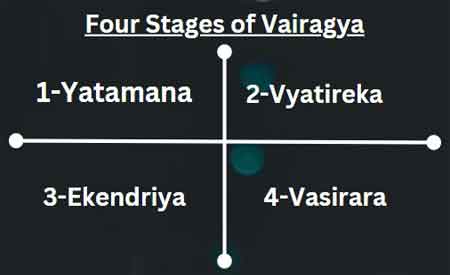Introduction – Four Stages of Vairgaya
Vairagya is a gradual process that involves 4 stages, and the Four Stages of Vairagya are Yatamana, Vyatireka, Ekendriya, and Vasirara. Each of these stages represents a step towards attaining complete detachment and inner peace.

Four Stages of Vairgaya are
- Yatamana is the stage of effort and discipline, where Practitioner focuses on controlling the mind and senses.
- Vyatireka is the stage of dispassion and detachment, where Practitioner learns to let go of worldly desires and attachments.
- Ekendriya is the stage of Practitioner-pointedness, where Practitioner focuses all their energy on a single point or goal.
- Vasirara is the stage of total renunciation, where Practitioner renounces all material possessions and desires and focuses solely on spiritual growth.
1-) Yatamana-The Stage of Effort and Discipline
What is Yatamana?
Yatamana is a Sanskrit word that means effort or discipline. It is the stage where Practitioner cultivates the virtues of perseverance, consistency, and self-discipline in order to achieve their goals. Yatamana is an important aspect of spiritual growth and is practiced in many spiritual traditions. It is considered to be Practitioner of the fundamental practices for achieving success in life.
Significance of Yatamana in Vairagya
Vairagya is a Sanskrit word that translates to dispassion or detachment. It is the stage where Practitioner detaches themselves from material desires and worldly attachments. Yatamana is an important aspect of Vairagya as it helps Practitioner cultivate the discipline needed to detach from worldly desires. Yatamana helps Practitioner overcome the obstacles that prevent them from achieving spiritual growth.
How to cultivate Yatamana in daily life?
Cultivating Yatamana in daily life requires consistent effort and discipline. Practitioner can start by setting achievable goals and working towards them consistently. It is important to stay focused on the goal and not get distracted by external factors. Cultivating Yatamana also requires self-awareness and self-discipline. Practitioner must be aware of their thoughts and actions and be willing to take corrective measures when needed.
2-) Vyatireka-The Stage of Dispassion and Detachment
What is Vyatireka?
Vyatireka is a Sanskrit term used in Indian philosophy to describe the stage of dispassion and detachment in the process of achieving Vairagya or detachment from worldly attachments. It is the fourth stage of Vairagya, preceded by the stages of Pratyahara (withdrawal of senses from external stimuli), Dharana (concentration), and Dhyana (meditation).
In Vyatireka, Practitioner has achieved a level of detachment from both positive and negative experiences. It is a state where Practitioner can observe the external world without getting affected by it. In other words, Practitioner has achieved a sense of equanimity and balance in life.
Significance of Vyatireka in Vairagya
The significance of Vyatireka in Vairagya is that it helps Practitioner to overcome the dualities of pleasure and pain, success and failure, praise and blame, and so on. It is an essential step towards achieving spiritual enlightenment and ultimate liberation.
How to cultivate Vyatireka in daily life?
To cultivate Vyatireka in daily life, Practitioner can practice mindfulness meditation, where they observe their thoughts and emotions without getting attached to them. Practitioner can also practice detachment from material possessions and focus on inner fulfillment rather than external achievements. Developing a sense of gratitude and compassion towards others can also help in cultivating Vyatireka.
3-) Ekendriya: The Stage of Practitioner-Pointedness
What is Ekendriya?
Ekendriya is a Sanskrit term that refers to the state of having Practitioner-pointed or concentrated mind. It is a state of inner focus where all of our senses are withdrawn and focused on a single object or task.
Significance of Ekendriya in Vairagya
In the context of Vairagya, or the path of detachment and renunciation in Hindu philosophy, Ekendriya is seen as an important goal. By cultivating this state of concentrated focus, we are able to detach ourselves from the distractions of the external world and turn inward, ultimately leading to a greater sense of inner peace and spiritual realization.
How to cultivate Ekendriya in daily life?
To cultivate Ekendriya in daily life, it is helpful to practice meditation and mindfulness. By setting aside time each day to sit quietly and focus on a single point of concentration, such as the breath or a mantra, we can train our minds to become more focused and Practitioner-pointed. Additionally, we can work to reduce external distractions in our environment, such as turning off our phPractitioners or minimizing background noise, to help us maintain a sense of inner calm and concentration.
4-) Vasirara-The Stage of Total Renunciation
What is Vasirara?
Vasirara is a Sanskrit term that refers to the stage of total renunciation in Hindu philosophy. It is the final stage of Vairagya, or the path of detachment and renunciation, where the seeker completely withdraws from the material world and focuses solely on spiritual pursuits.
Significance of Vasirara in Vairagya
In Vasirara, the seeker renounces all possessions, relationships, and attachments, and lives a life of solitude and contemplation. This stage is considered to be the highest level of spiritual realization, as the seeker is completely devoted to the pursuit of ultimate truth and liberation.
How to cultivate Vasirara in daily life?
To cultivate Vasirara in daily life, it is important to first cultivate a strong foundation of detachment and renunciation through the earlier stages of Vairagya. This may involve practicing mindfulness and meditation, reducing material possessions and attachments, and cultivating a sense of detachment from the external world.
Final Words
The four stages of Vairagya (Yatamana, Vyatireka, Ekendriya, and Vasirara) are crucial in helping individuals develop a sense of detachment and become more focused on their spiritual pursuits. By practicing Four Stages of Vairagya, Practitioner can develop a deeper understanding of the self, gain inner peace, and move towards spiritual enlightenment. Ultimately, the practice of Four Stages of Vairagya can lead to a profound transformation of Practitioner’s being, enabling them to live a life of purpose, meaning, and fulfilment.
Read More Articles
Unlock Your Inner Power with Vairagya in Yoga
What is Isha Kriya?
Join Our Facebook Page
Author
Rajat Maheshwari



